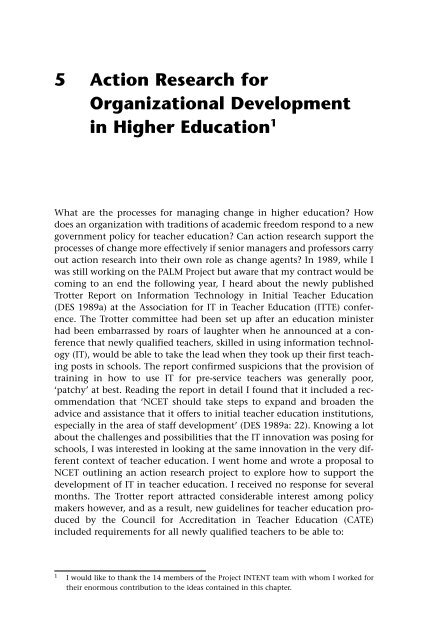Action Research A Methodology for Change and Development
Action Research A Methodology for Change and Development
Action Research A Methodology for Change and Development
Create successful ePaper yourself
Turn your PDF publications into a flip-book with our unique Google optimized e-Paper software.
5 <strong>Action</strong> <strong>Research</strong> <strong>for</strong><br />
Organizational <strong>Development</strong><br />
in Higher Education 1<br />
What are the processes <strong>for</strong> managing change in higher education? How<br />
does an organization with traditions of academic freedom respond to a new<br />
government policy <strong>for</strong> teacher education? Can action research support the<br />
processes of change more effectively if senior managers <strong>and</strong> professors carry<br />
out action research into their own role as change agents? In 1989, while I<br />
was still working on the PALM Project but aware that my contract would be<br />
coming to an end the following year, I heard about the newly published<br />
Trotter Report on In<strong>for</strong>mation Technology in Initial Teacher Education<br />
(DES 1989a) at the Association <strong>for</strong> IT in Teacher Education (ITTE) conference.<br />
The Trotter committee had been set up after an education minister<br />
had been embarrassed by roars of laughter when he announced at a conference<br />
that newly qualified teachers, skilled in using in<strong>for</strong>mation technology<br />
(IT), would be able to take the lead when they took up their first teaching<br />
posts in schools. The report confirmed suspicions that the provision of<br />
training in how to use IT <strong>for</strong> pre-service teachers was generally poor,<br />
‘patchy’ at best. Reading the report in detail I found that it included a recommendation<br />
that ‘NCET should take steps to exp<strong>and</strong> <strong>and</strong> broaden the<br />
advice <strong>and</strong> assistance that it offers to initial teacher education institutions,<br />
especially in the area of staff development’ (DES 1989a: 22). Knowing a lot<br />
about the challenges <strong>and</strong> possibilities that the IT innovation was posing <strong>for</strong><br />
schools, I was interested in looking at the same innovation in the very different<br />
context of teacher education. I went home <strong>and</strong> wrote a proposal to<br />
NCET outlining an action research project to explore how to support the<br />
development of IT in teacher education. I received no response <strong>for</strong> several<br />
months. The Trotter report attracted considerable interest among policy<br />
makers however, <strong>and</strong> as a result, new guidelines <strong>for</strong> teacher education produced<br />
by the Council <strong>for</strong> Accreditation in Teacher Education (CATE)<br />
included requirements <strong>for</strong> all newly qualified teachers to be able to:<br />
1 I would like to thank the 14 members of the Project INTENT team with whom I worked <strong>for</strong><br />
their enormous contribution to the ideas contained in this chapter.

















